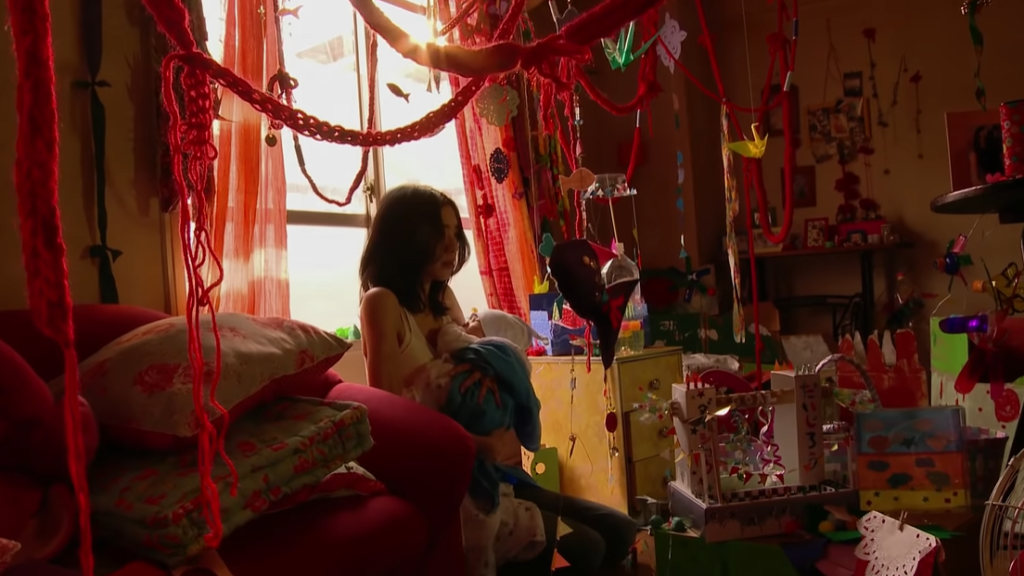Kotoko
2011

Rated: NR
Genre: Drama, Horror
Country: Japan
Run-Time: 1h 31min
Director: Shin’ya Tsukamoto
Cast
Cocco…………………………………………….Kotoko
Shin’ya Tsukamoto …………………Seitaro Tanaka
Shin’ya Tsukamoto films can be tough to watch, but I am biased since my introduction to his work came after watching Tetsuo: The Iron Man on my couch while running a high fever. I do not recommend anybody trying this. Tetsuo: The Iron Man is one of the most aggressively nauseating experimental films ever made. It is Eraserhead on speed.
Released in 2011, Tsukamoto filmed Kotoko over twenty years after his cult hit Tetsuo: The Iron Man and it is striking how much he has matured as a director. Don’t get me wrong, Kotoko still comes at you with all the force of a semi truck, it is just that this time there are a few quieter beats designed to break your heart before it runs you over. Tsukamoto has now figured out how to emotionally crush an audience as well. With Kotoko, Tsukamoto proves he has become even more dangerous, and more prolific.
Kotoko’s opening is fantastic in its use of sound. We start seeing a young girl dancing alone on the beach as music eerily plays. Then, in a quick flash, the girl is gone, but the beach remains, and the music is replaced by the sounds of frantic screams. What did watch? Is this a past childhood trauma? Was the girl Kotoko, or someone she knew? A sister or daughter? A hallucination? Cue title card.
Next, we see Kotoko (Cocco), a young woman trying her best to cope with her day. She tells us she “sees double” which means that she often sees two versions of the same person. Often, both versions will go about their business normally. But eventually the doppelganger will turn aggressive and come at Kotoko in a rage-filled fury that might remind you of the infected from 21 Days Later… . This affliction has turned Kotoko into a recluse. She has also turned to cutting “to make sure I’m still alive.”
Kotoko is a mess, and her life is not easy, so the delayed reveal she has a baby is particularly devastating. If you are sensitive to horror that involves young children, you may want to stay away from this one.
Kotoko is the debut performance for J-pop sensation Cocco, who also wrote the original script. Cocco has said that the film is loosely based on her own experiences, making the project a particularly personal one and it shows in her performance. Tsukamoto, who also acts and helped to adapt the screenplay, seems to have also fully bought in to Cocco’s vision as he films this nightmare with surprising sensitivity. It’s an odd, ugly, yet magical collaboration by two unique artists who on this project are on the same wavelength.
Having watched the film, my guess is that Kotoko either suffers from postpartum psychosis- which is a far more severe form of postpartum depression- or else she is a paranoid schizophrenic. Based on the severity of her illness, I tend to believe the latter, though an understanding of the former helps to better ground the tragic horrors of the film to an extreme version of a more common condition, giving it film additional relevance. Kotoko also has hellish abduction fantasies when she loses the fight with her imaginary demons, especially when she is facing a male doppelganger. Perhaps, as a result, she takes a pleasure in “real world”- assuming what we see is the “real world”- harming men who take an interest in her. In her own words, “I am not a good person.”
I don’t blame you if you find the first fifteen minutes of Kotoko a bit intense. Enough happens in those early scenes that this portion alone could had been stretched into a full-length feature. But eventually Kotoko will allow for a few quieter moments. There are long takes of Kotoko singing her sad songs, as we are told that singing is the only thing that helps keep her hallucinations in check. These breaks also allow Cocco a chance to show off her hypnotic voice, which I did not mind considering how vicious the rest of the film is. Considering Kotoko’s character lacks a comprehensive backstory, the songs in Kotoko end up being our only real outlet to empathize with Kotoko.
As the film enters the midpoint, Kotoko’s self-destructive behaviour will start to feel a bit repetitive, but then Tsukamoto will introduce (himself as) a stalker novelist who has taken a fancy to Kotoko. The cracks of Tsukamoto’s films often ooze with dark humour, and in Kotoko it comes in the form of a sadistic, but wildly original courtship between two damaged people that learn how to bring about the best and worse in each other.
In many ways, Kotoko is a perfect example of the potential of adult horror. It is a mature work by an innovative filmmaker who understands how to use horror and extreme content in thought provoking ways. This is a film that elicits strong emotions while simultaneously showing us the frailty of the human condition. At times, Kotoko is a beautiful, almost lyrical film. More often it is horrible, even extreme. Never is it boring. And frankly, it is one of the most entertaining and distressing examples of mental illness even put on film.
